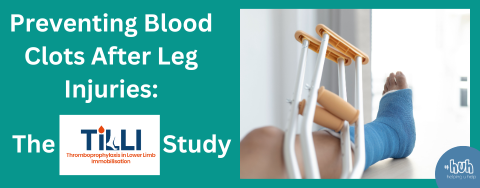Patients with leg injuries requiring immobilisation with a cast, boot, or splint are at higher risk of developing blood clots in the leg. This is called deep vein thrombosis (DVT) [1]. A DVT can cause local problems in the leg. If it dislodges and moves to the lung, it can cause a pulmonary embolism (PE) [2], which can be life-threatening. Together DVT and PE are known as venous thromboembolism (VTE).
Dr Jamie Cooper, Consultant at Aberdeen Royal Infirmary Emergency Department, explained: "The risk of VTE varies greatly between individuals. It is dependent on several factors related to the patient, injury and treatment. As a result, there is extensive variation in the recommendations of national guidelines, and in routine clinical practice, regarding who should receive therapy to reduce the risk of VTE during lower limb immobilisation and whether this should be in the form of injectable or oral medication."
The Thromboprophylaxis in Lower Limb Immobilisation (TiLLI) study is led by the Queen Mary University of London. It aims to determine the safest, most effective, and cost-efficient strategy to prevent VTE in patients who are treated with lower-limb immobilisation after injury. The study plans to recruit around 10,000 participants aged 16 and over from hospitals across the UK.
The TiLLI study has two parts:
TiLLI-High: This focuses on people at a higher risk of VTE. Researchers will compare two types of medications: injectable and oral blood thinners [3].
TiLLI-Low: This looks at people with a lower risk of VTE. Its aim is to determine whether taking any medication, injectable or oral, has any clinical benefit over no treatment.
The study opened at Aberdeen Royal Infirmary in December 2024. Our research team in the Emergency Department has enrolled 27 participants to date and is TiLLI’s top recruiter! Well done team!
For more details visit the TiLLI factsheet here F-24092024-TiLLI_TUK_Preventing-Blood-Clots_Fact-Sheet_V3.pdf
1 https://www.nhs.uk/conditions/deep-vein-thrombosis-dvt/
